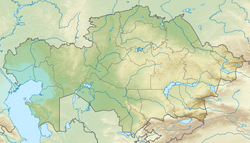| Manrak Formation | |
|---|---|
| Stratigraphic range: Campanian ~ | |
| Type | Geological formation |
| Lithology | |
| Primary | Sandstone, claystone |
| Location | |
| Coordinates | 47°42′N84°06′E / 47.7°N 84.1°E |
| Approximate paleocoordinates | 43°06′N74°24′E / 43.1°N 74.4°E |
| Region | Shyghys Qazaqstan, Aqmola |
| Country | Kazakhstan |
The Manrak Formation (Russian: Manrakskaya Svita) is a Campanian geologic formation in Kazakhstan. Fossil dinosaur eggs have been reported from the formation. [1]
